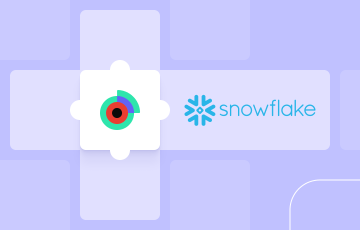
Combine personalization and A/B testing to increase your turnover
![]() ACADEMY / Personalization training blog
ACADEMY / Personalization training blog
Given the related nature of A/B testing and personalization when should you favor one rather than the other?
In this article, we explain how to significantly increase your revenues and margins by balancing personalization and A/B testing.
Most marketers now regularly use testing and personalization to optimize the user experience. This is great news for site visitors, who now enjoy increasingly high quality, seamless and individual browsing experiences. Given the related nature of A/B testing and personalization when should you favor one rather than the other? Do you really have to choose between them? How can you effectively combine them?
While it all depends on your goal, by using the two together you can maximize your results. In this article, we explain how to significantly increase your revenues and margins by balancing personalization and A/B testing.
1 Personalization and A/B testing: two different but complementary practices
Despite their differences, it is important to understand that personalization and A/B testing ultimately fulfil a common goal: that of optimizing a website to offer your visitors a higher quality experience, improving your conversion rates and increasing your turnover.
A/B testing in a nutshell
A/B testing involves incremental optimization. That’s because if you really want to understand what is causing variations in conversion rates, it is best to only modify one element at a time. Testing is essential for optimizing the elements of your website that remain the same for all your visitors, such as the menu, the number of steps in your conversion funnel, the place or number of fields to complete in your forms.
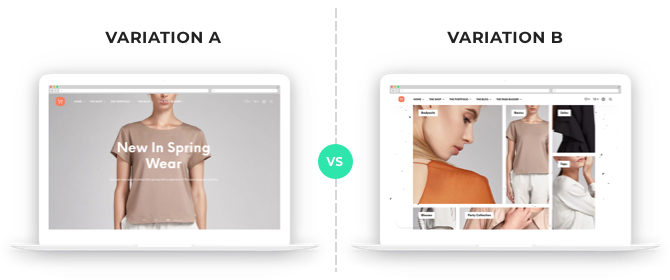
A/B testing involves incremental optimization. That’s because if you really want to understand what is causing variations in conversion rates, it is best to only modify one element at a time. Testing is essential for optimizing the elements of your website that remain the same for all your visitors, such as the menu, the number of steps in your conversion funnel, the place or number of fields to complete in your forms.
Personalization in a nutshell
Personalization is an optimization practice enabling marketers to construct contextualized browsing journeys for their individual visitors based on who they are and what they are looking for when they come to your website.

The possibilities are endless - you can personalize the experience of each visitor by cross-referencing very precise segmentation criteria:
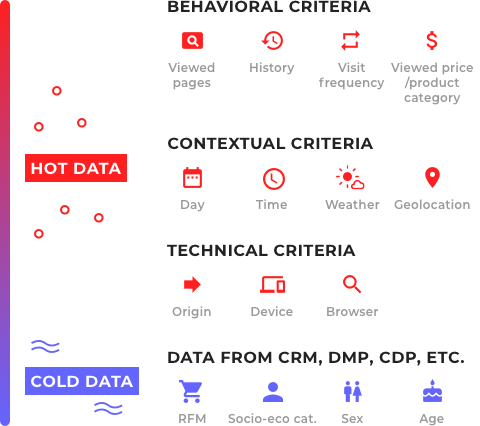
AN EXAMPLE TO SHOW HOW EACH PRACTICE WORKS DIFFERENTLY
A movie theater wants to optimize its conversions and sell more tickets online. There are two possibilities:
1. Optimize the overall website experience
2. Construct a browsing experience adapted to each visitor.
For the first possibility, we set up an A/B test. What if the conversion funnel or booking tickets is too long and complicated? The marketing team comes up with several variations of their conversion funnel and puts them to the test.
Following the test, the brand adopts the variation that generates the most conversions. In our example, the B variation generates 15% more bookings than the original, variation A. It is therefore shown to all visitors.
For the second possibility, you need to think differently and shift from a macro vision of your audience to a micro one. The challenge here is to identify the interests of each website visitor to individually offer them a better experience. For example, “what types of films do they wish to book when they come to your website?” By studying the purchasing behavior of your customers, you could for example build a “fan of horror films” segment and include in it the visitors who have seen more than three horror films over the past 12 months.
By doing this, and with the help of a personalization platform, you can create a unique experience for these visitors and recommend must-see horror films to encourage them book online. On the left - the home page of a first-time visitor On the right - the home page of our fan of horror films.

A/B testing and personalization are NOT INTERCHANGEABLE
Remaining with the same example our movie theater wants to identify which type of film sells the most tickets. We run an A/B test: Two customers visit the website to make a booking (let’s call them John and Caroline).
Randomly, a program of science-fiction films is proposed to John, while Caroline sees a list of horror films. After thousands of visitors have been tested, the movie theater determines which list allows them to sell the most tickets.
What’s the problem with this experiment? The lack of relevance. Only fans of science-fiction and horror films will be receptive to such an experiment. If neither John nor Caroline like these genres, then their opinions are biased and have no statistical value for the movie theater’s marketing.
Conversely, if we use a personalization solution, we can determine from John’s browsing and purchase histories that he is a horror film buff. We can then make suitable recommendations for him.
We don’t know Caroline yet, but since she arrived on the website by looking for information on a science-fiction film,, there’s a good chance that displaying a list of films in that genre will encourage her to book a ticket. In short:
- A/B testing = iterative ergonomic optimization (technical optimization)
- Personalization = contextualization of each visitor’s experience (strategic optimization)
Now that you understand the difference and the challenges of each practice, let’s look at how you can combine them. We will take the optimization strategy of French travel website routard.com as an example.
2 How can you combine personalization and A/B testing to optimize your website?
Let’s look at two campaigns (one involving testing, and one involving personalization), run on the same page at Routard.com, with very different challenges and methods.
A/B TEST ON THE ROUTARD.COM HOMEPAGE
Routard.com’s optimization team redesigned the brand’s home page to optimize its performance (aiming to boost overall visitor engagement and to reduce the page’s bounce rate). For this redesign, they ran an A/B test comparing the performance of the new page against the original page.
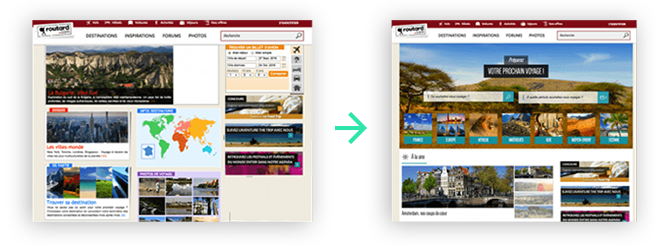
The A/B test showed that the new home page reduced the bounce rate by 14%.
“We adopted an iterative approach. When we have an idea, we put it to the test, measure the results and decide whether or not to apply it. Whatever the result, we continue to test.”
Thomas Sauzedde, Managing Director, Routard.com
PERSONALIZATION OF THE ROUTARD.COM HOME PAGe
The challenge for the ensuing personalization campaign was to build a unique and contextualized experience for each visitor as soon as they land on the home page.
When a visitor returns to the Routard.com website, Kameleoon activates a sub-menu that is entirely personalized according to the destinations they were looking at on their previous visit. The goal is to re-immerse the visitor in the destination that seems to interest them and push them to interact with the website content.
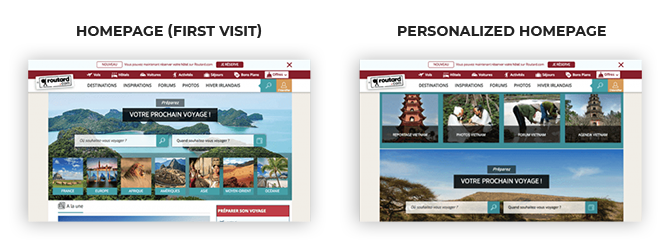
This example maps out the journey of a visitor who looked into Vietnam during a previous visit. During a subsequent visit, a menu that is personalized around Vietnam is displayed. As the website makes personalized product recommendations based on their previous behavior, each visitor receives a completely different experience when they return.
By combining personalization and A/B testing, you make it possible to deliver a quality browsing experience without losing sight of what is most important: what your visitors are individually looking for.
Additionally new solutions enable you to deploy increasingly advanced segmentation capabilities. By integrating artificial intelligence and the power of machine learning algorithms into your personalization strategy, you can perform very precise segmentation and even calculate the conversion probability of visitors in a segment in real-time so that you can offer them even more relevant and timely experiences.
![]() ACADEMY / Return to our Personalization training course by clicking here.
ACADEMY / Return to our Personalization training course by clicking here.


